Dive into Montessori playroom ideas, where each corner and crevice is meticulously designed to nurture your child’s thirst for knowledge and creativity. In the Montessori philosophy, playrooms are more than play areas; they are dynamic learning environments that encourage self-guided exploration and discovery. This blog will explore various Montessori playroom ideas that blend aesthetics with functionality, creating spaces that resonate with children’s innate curiosity and developmental needs.
Montessori playroom ideas are essential for crafting education that ignites imagination and fosters cognitive and emotional growth. These playrooms are characterized by their emphasis on independence, structured learning, and natural aesthetics. As we delve deeper, you’ll gain insights into selecting the suitable materials, furniture, and layouts embody the Montessori spirit, ensuring your playroom is an area of inspired learning and personal development.
Implementing Montessori playroom ideas means creating a versatile environment that grows with your child, seamlessly blending play and education. These spaces are carefully designed to encourage choice, independence, and concentration, providing the best help for your child’s development. From practical storage solutions to sensory-rich activities, discover how Montessori playroom ideas can shape an environment where your child can explore, learn, and grow in harmony with their natural development path.
What Is Montessori Learning Method?
The Montessori learning method is an innovative educational approach emphasizing active, self-directed learning in a prepared environment. It fosters children’s natural drive for discovery and learning through hands-on activities and collaborative play. This method champions the idea that education should be tailored to each child’s individual pace, interests, and abilities, encouraging them to explore and learn naturally. Montessori education prioritizes holistic development to cultivate academic skills and social, emotional, and physical growth.
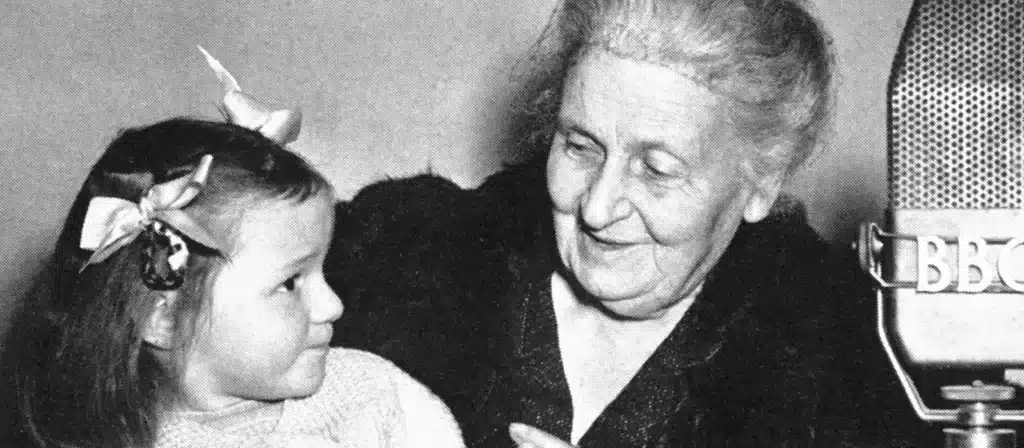
The Philosophy Behind Montessori Playroom Ideas
The philosophy behind Montessori playroom ideas is grounded in the belief that children learn best in environments where they can independently initiate and engage in activities. This educational approach emphasizes creating a space where children can explore freely, with materials and activities that cater to their evolving interests and developmental stages. The aim is to cultivate an atmosphere where children can experience learning as a natural, enjoyable process, promoting their autonomy, self-esteem, and intrinsic motivation to discover and understand the world around them.
The Importance of a Well-Designed Playroom
The significance of a well-designed playroom cannot be overstated in the Montessori philosophy.
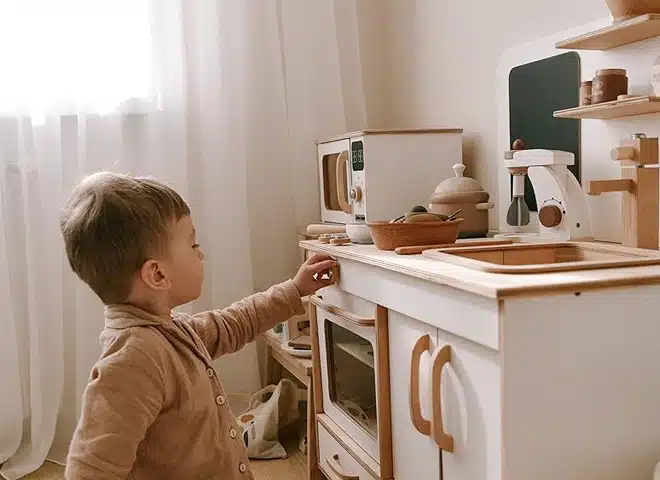
Impact on Learning
The design of a playroom profoundly influences a child’s learning experience, catalyzing developmental growth. In a Montessori playroom, every element is purposefully placed to enhance focus, foster independent learning, and stimulate intellectual curiosity. This intentional environment allows children to immerse themselves in activities that build foundational skills and knowledge, setting the stage for lifelong learning.
Encourages Exploration
A well-crafted Montessori playroom is pivotal in sparking a child’s natural curiosity and drive for exploration. It offers a variety of materials and activities that invite children to investigate, experiment, and learn through direct interaction with their environment. This constant engagement fuels their desire to understand the world, enhancing their cognitive development and problem-solving skills.
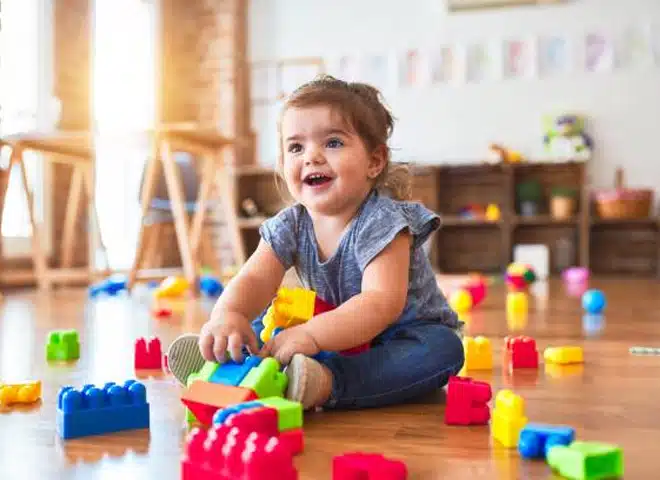
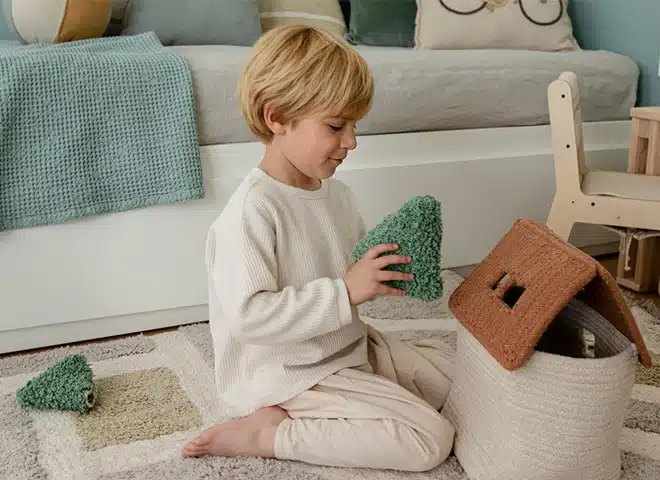
Promotes Organization Skills
A Montessori playroom with clear structure and order inherently teaches children organizational skills. By interacting with a space where every item has its place, children learn to categorize, arrange, and maintain their environment. This hands-on approach keeps the playroom tidy and instills valuable life skills in children, enabling them to apply these organizational principles in broader aspects of their lives.
Nurtures Emotional Well-being
A meticulously designed Montessori playroom is crucial to a child’s emotional growth. It offers a stable and comforting environment where children feel safe to express themselves and explore their interests. This sense of security and belonging fosters emotional resilience and self-esteem, empowering children to take initiative and engage confidently in learning activities.
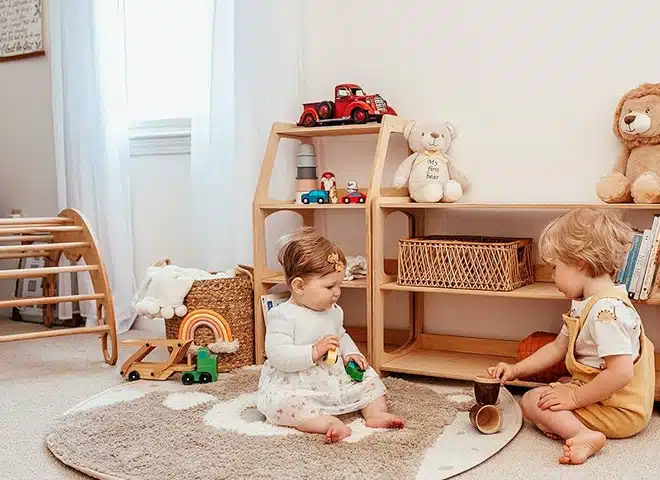
Creating a Montessori Playroom
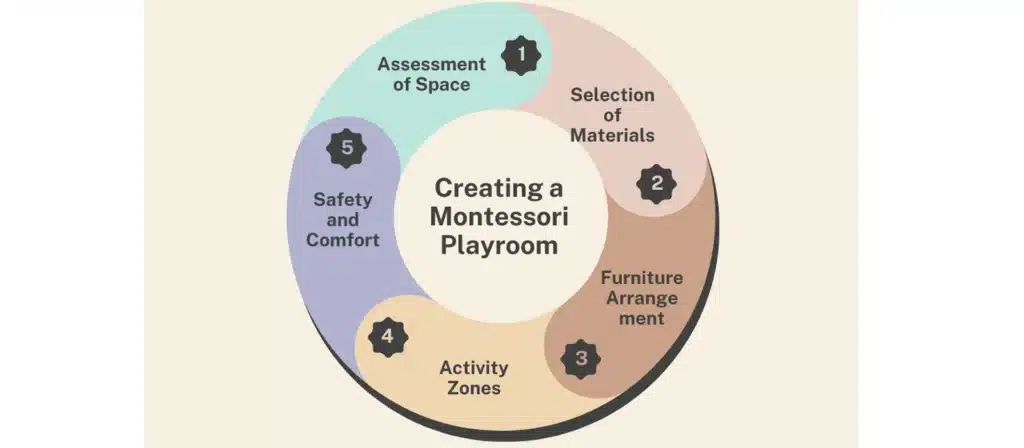
- Assessment of Space: Evaluate the available space to determine how it can best be utilized to create a functional and inviting play area. Consider factors like lighting, noise levels, and room layout. An ideal Montessori playroom should be well-lit, preferably with natural light, to create a warm and inviting atmosphere. The space should be quiet enough to allow concentration yet accessible for children to feel part of the family dynamic.
- Selection of Materials: Choose age-appropriate materials that align with Montessori principles, focusing on quality and purpose. Opt for items encouraging hands-on learning and exploration, such as sensory toys, practical life tools, and nature-based activities. The materials should be durable, safe, and designed to stimulate the child’s senses and imagination, aiding in developing fine motor skills and cognitive abilities.
- Furniture Arrangement: Incorporate child-sized furniture to promote independence and accessibility. Arrange these pieces thoughtfully to ensure children can move freely and safely in the space. Furniture should be sturdy, appropriately sized, and proportionate to the child’s height, allowing them to sit comfortably and reach items without assistance. This setup empowers children to take charge of their learning environment.
- Activity Zones: Designate areas within the playroom for specific activities, such as reading, art, building, and imaginative play. This helps organize the space and guide the child’s learning experiences. Each zone should be clearly defined by area rugs or shelving units to signal where each activity should occur to the child. This segmentation helps in maintaining order and focus within the playroom.
- Safety and Comfort: Ensure the playroom is safe and comfortable, with non-toxic materials and soft, inviting areas where children can relax and recharge. Safety features, such as rounded corners, secure shelving, and non-slip surfaces, are paramount. Comfort can be enhanced by adding soft rugs, cushions, or a quiet corner, creating a soothing environment conducive to active play and rest.
Montessori Playroom Ideas Design Principles
Designing a Montessori playroom, as outlined in Montessori playroom ideas, emphasizes simplicity, functionality, and natural beauty, creating an intuitively organized and child-centric environment. These ideas advocate for a design that facilitates easy access to materials, promoting independence and self-directed activity. Montessori playroom ideas often incorporate natural materials and a calming color palette to establish a connection with the natural world, providing a serene backdrop for learning. The space, guided by Montessori playroom principles, should be adaptable, able to grow and change with the child, and meticulously organized to encourage order and self-discipline. Following these Montessori playroom ideas ensures the playroom is a place where children feel empowered to explore, learn, and develop at their own pace.
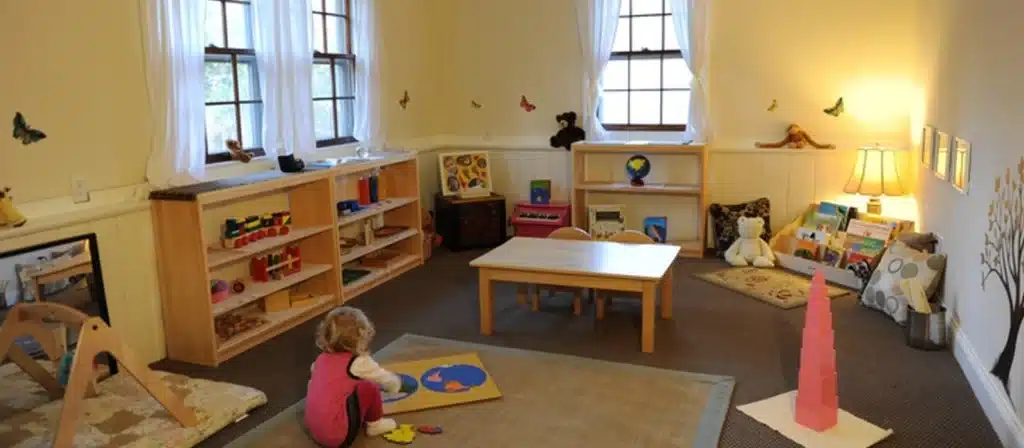
Elements of Montessori Playroom Ideas
- Varied Learning Materials: Central to Montessori playroom ideas are the learning materials chosen for their ability to engage and educate. These include tactile objects like puzzles and building blocks that promote problem-solving and fine motor skills. The selection should cater to various activities that cover different learning domains, such as language, mathematics, sensory development, and practical life skills.
- Activity-Based Zones: Dividing the playroom into distinct areas or zones for different activities can enhance learning experiences. For instance, a reading nook encourages quiet time and literacy, while an art station with accessible supplies invites creativity. Each zone is tailored to specific types of play and learning, helping children make connections between different activities and skills.
- Natural and Aesthetic Elements: Incorporating natural elements and materials like wood, cotton, and plants brings a piece of the outside world into the playroom. This adds aesthetic value and connects children with nature, encouraging exploration and discovery. Using natural light and soft, neutral colors creates a calming and inviting space.
- Interactive and Sensory Experiences: Providing interactive and sensory play opportunities is crucial. This could include sand and water tables, musical instruments, or textured fabrics and materials. These experiences stimulate the senses and support cognitive and motor development, offering children a hands-on approach to learning.
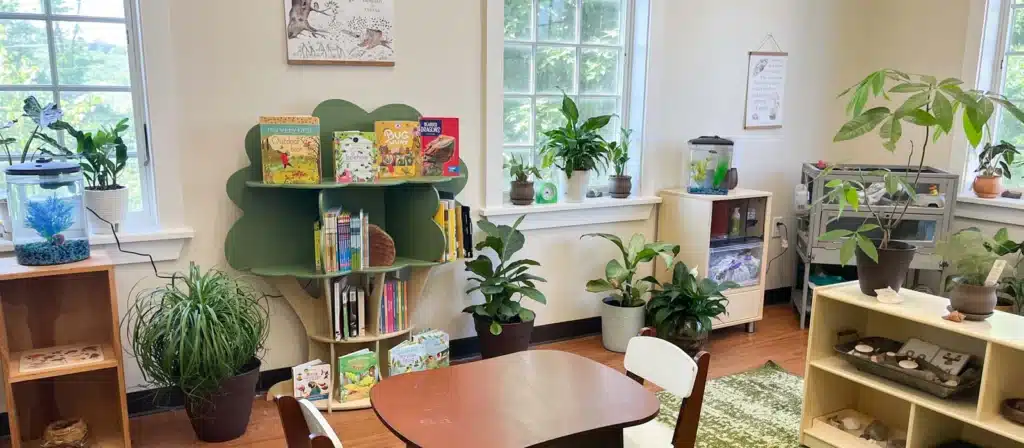
The Right Furniture and Materials
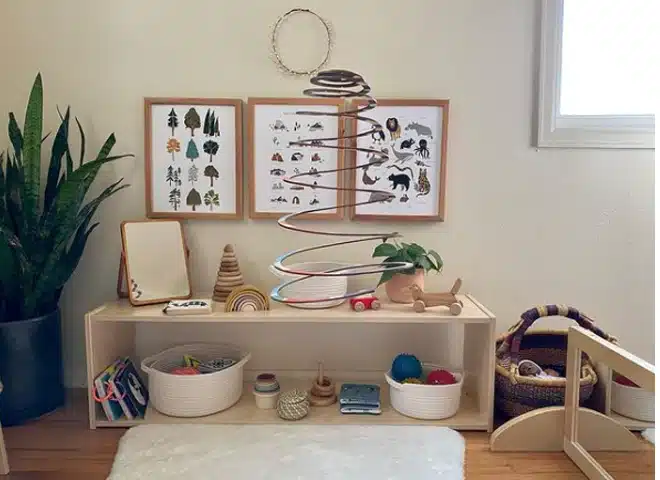
Child-Sized Furniture
Furniture in a Montessori playroom should be sized just right for the children using the space. Examples include low tables and chairs children can easily sit at and get up from, promoting independence and comfort. Small shelves allow children to reach toys and materials without assistance, fostering self-reliance.
Durable and Safe Materials
The materials used in the playroom should be durable and safe, able to withstand the rigors of daily use. Wooden toys, for example, are robust and offer a sensory experience different from plastic. Soft mats or rugs can provide safe surfaces for children to play and move on, reducing the risk of injury.
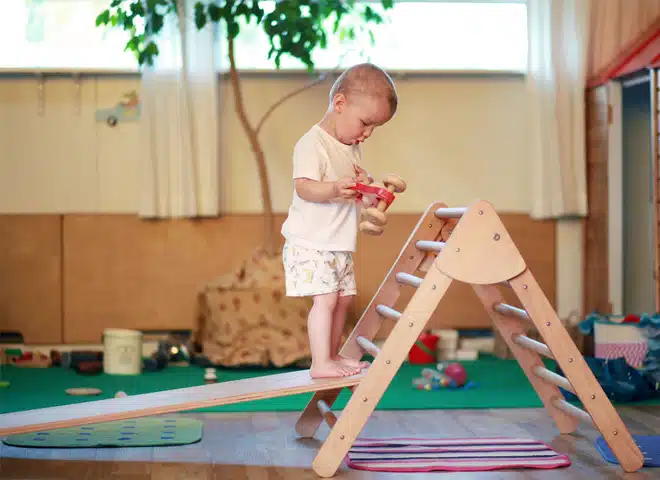
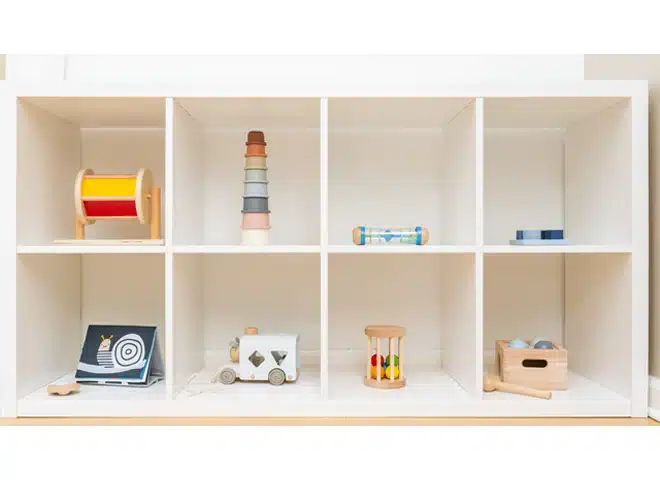
Functional Storage Solutions
Practical storage solutions keep the playroom organized and accessible. Open shelving units where toys and materials are displayed at the child’s eye level enable children to choose what they want to play with, promoting decision-making. Bins and baskets labeled with pictures or words help children learn where items belong, aiding in clean-up and organizational skills.
Adaptive and Interactive Pieces
Incorporating furniture and materials that can adapt to various activities enhances the playroom’s functionality. For instance, adjustable tables can serve multiple purposes for arts and crafts, sensory play, or snack time. Interactive elements like magnetic boards, chalkboards, or felt boards encourage creativity and can be changed regularly to keep the environment fresh and engaging.
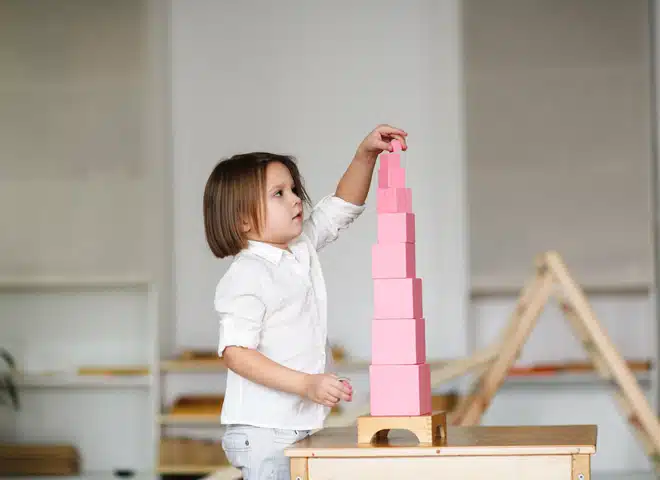
Incorporating Nature into the Playroom
Incorporating natural elements into Montessori playroom ideas extends the educational philosophy’s emphasis on creating harmonious and reflective learning spaces. This approach ensures the indoor environment resonates with the natural world, fostering children’s connection to nature and enriching their sensory experiences. By integrating aspects like natural light, plant life, and materials derived from the earth, Montessori playroom ideas become a living canvas of exploration and discovery, enhancing the child’s innate curiosity and respect for the natural environment.
Connection to the Natural World
Introducing elements from nature into the playroom helps establish a vital connection between children and the natural world. This can be achieved by including indoor plants, which improve air quality and offer children the chance to learn about caring for living things. Observing plant growth and changes can spark curiosity and a sense of responsibility in young minds.
Natural Materials and Textures
Utilizing natural materials like wood, stone, and cotton in the playroom’s design and toys encourages sensory exploration and learning. Wooden blocks, for example, provide a different texture and weight than plastic ones, offering a more grounding and tactile experience. Similarly, incorporating stone or clay can introduce children to various textures and temperatures, stimulating their sense of touch.
Incorporation of Natural Light and Colors
Maximizing natural light in the playroom enhances well-being and helps maintain a connection with the outdoor environment. Using colors inspired by nature, such as greens, browns, and blues, can create a calming and focused atmosphere. These colors mimic the outdoors and can make the playroom feel like an extension of the natural world, providing a serene and concentrated learning environment.
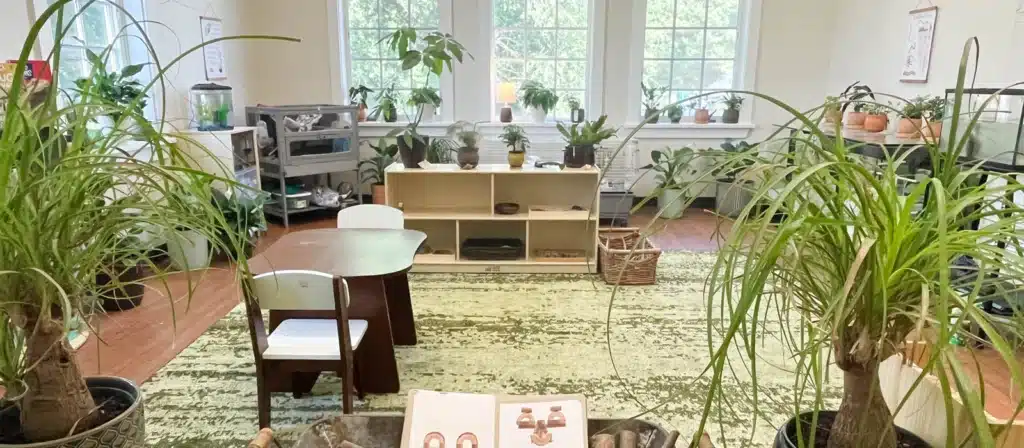
Promoting Independence and Self-directed Learning
Incorporating Montessori playroom ideas to promote independence and self-directed learning is fundamental in shaping a child’s educational experience. These ideas emphasize creating a playroom environment that encourages children to choose and engage in activities autonomously. By ensuring that resources are accessible and decisions can be made independently, Montessori playroom ideas help children develop a sense of agency and confidence. This empowerment is essential for fostering self-motivation and a love for learning, allowing children to navigate their educational journey at their own pace, guided by their interests and curiosity.
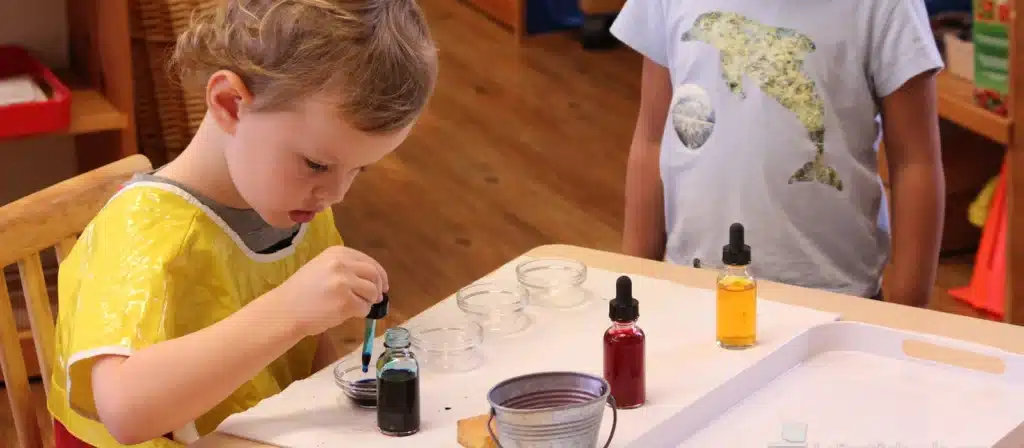
Organizing and Storing Materials
Effective organization and storage of materials are vital components of Montessori playroom ideas, ensuring that the environment remains orderly and conducive to learning. In a Montessori playroom, materials should be stored in a way that is easily accessible to children, allowing them to select and return items independently. This system promotes responsibility and aids in the development of organizational skills. Utilizing clear labels, open shelving, and child-height storage solutions can help children understand and maintain the arrangement of their play space, fostering a sense of ownership and respect for their learning environment.
Montessori Playroom Ideas for Different Age
| Age Range | Montessori Playroom Ideas |
| 0-3 months | Soft, high-contrast mobiles above the playmat; cozy, safe spaces for tummy time; gentle sensory toys with varied textures. |
| 3-6 months | Mirrors at floor level for self-exploration; simple grasping toys; soft books with basic patterns or images. |
| 6-9 months | Sit-to-stand toys; basic stacking and nesting toys; tactile play mats with different surfaces to explore. |
| 9-12 months | Pull and push toys to aid walking, shape sorters, and simple musical instruments like drums or xylophones. |
| 1-2 years | Dynamic play structures like low climbing frames; puzzles with large pieces; and art supplies like chunky crayons and large paper. |
| 2-3 years | More complex building sets; pretend play items like mini kitchens or dollhouses; introductory number and letter games. |
Balancing Modern Tools with the Montessori Method
Integrating modern tools with Montessori playroom ideas involves finding a balance where technology enhances rather than detracts from the hands-on, sensory experiences at the core of Montessori learning. Traditional materials that promote physical interaction and exploration are paramount in a Montessori playroom. However, selectively used digital tools, like tablets with educational apps, can complement these materials by supporting specific skills such as language or mathematics. The integration should be thoughtful, ensuring that these modern tools are used judiciously within the Montessori framework to enrich the child’s learning environment without overshadowing the essential tactile and interactive elements of Montessori playroom ideas.
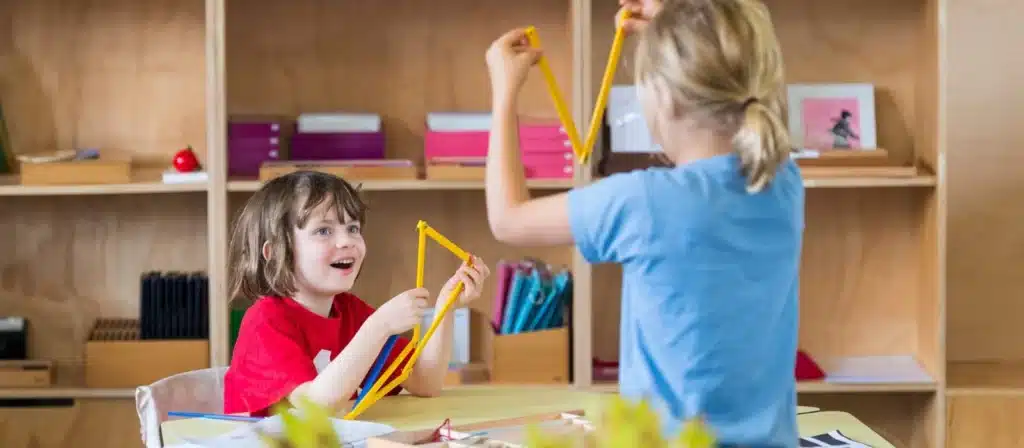
Conclusion: Creating a Caring Environment for Children
In conclusion, the essence of Montessori playroom ideas is to foster a caring and nurturing environment that supports every facet of a child’s development. A Montessori playroom becomes a place where children feel valued and understood by thoughtfully incorporating elements that stimulate learning, independence, and creativity. This environment encourages them to explore, discover, and grow in confidence and knowledge, laying a solid foundation for lifelong learning and well-being.










